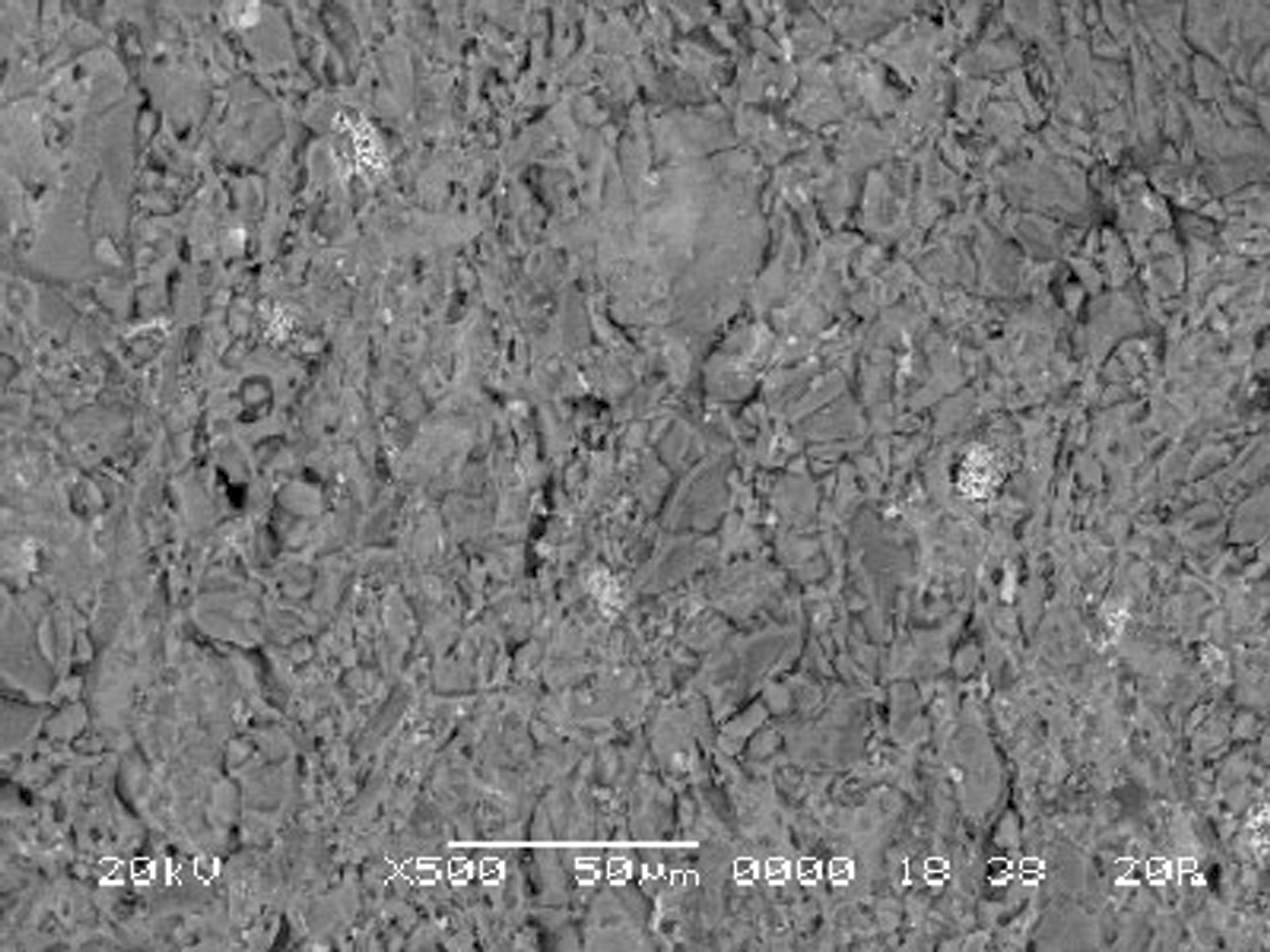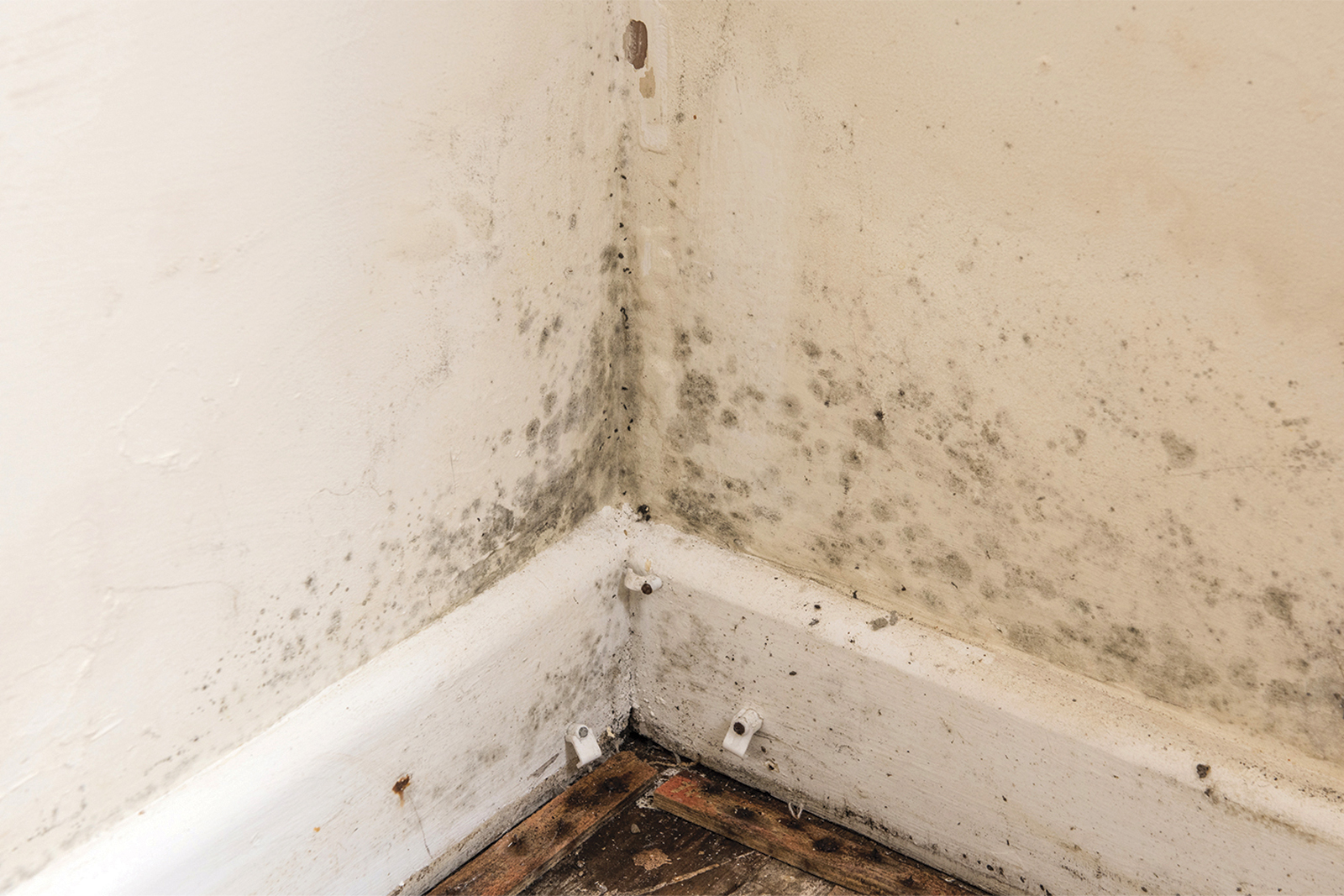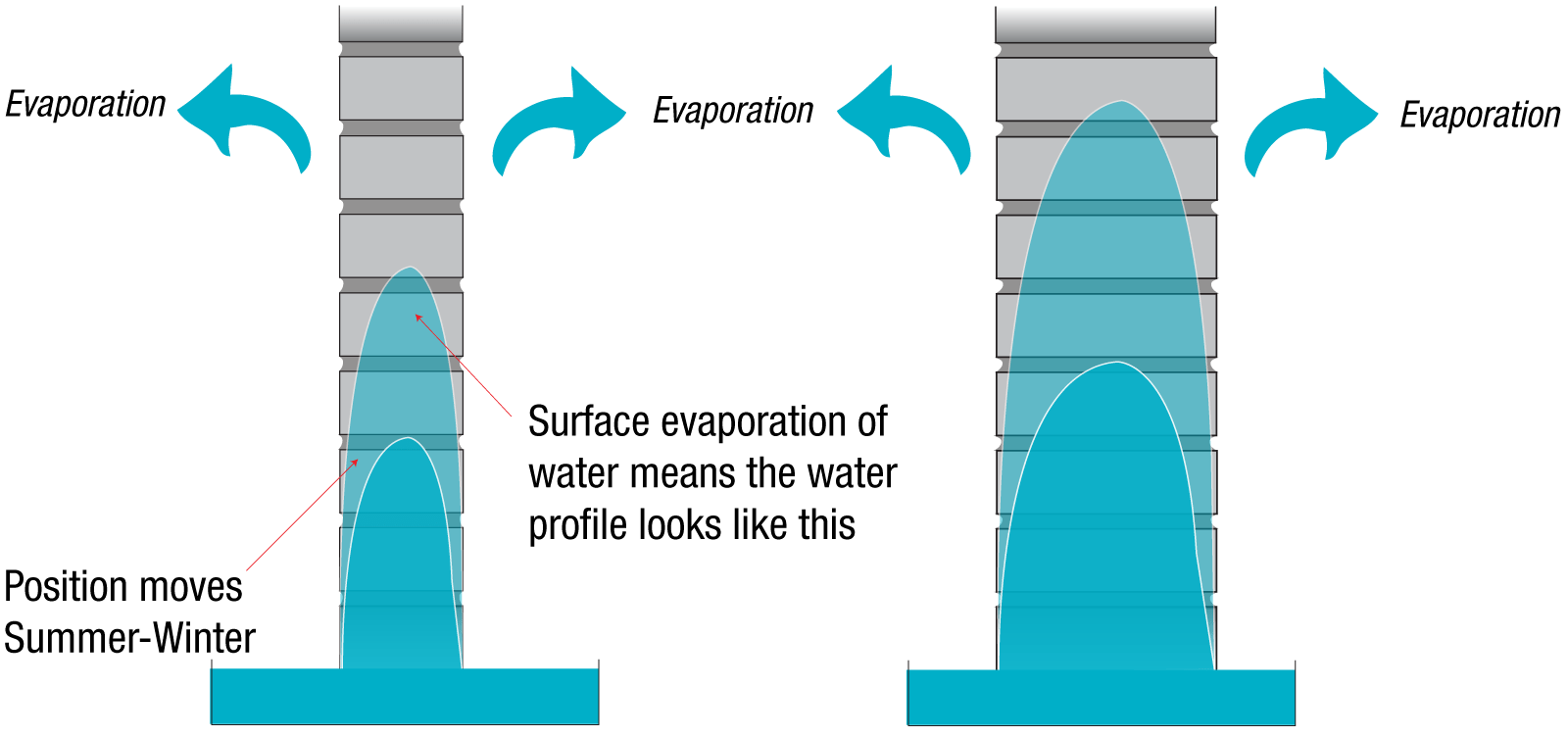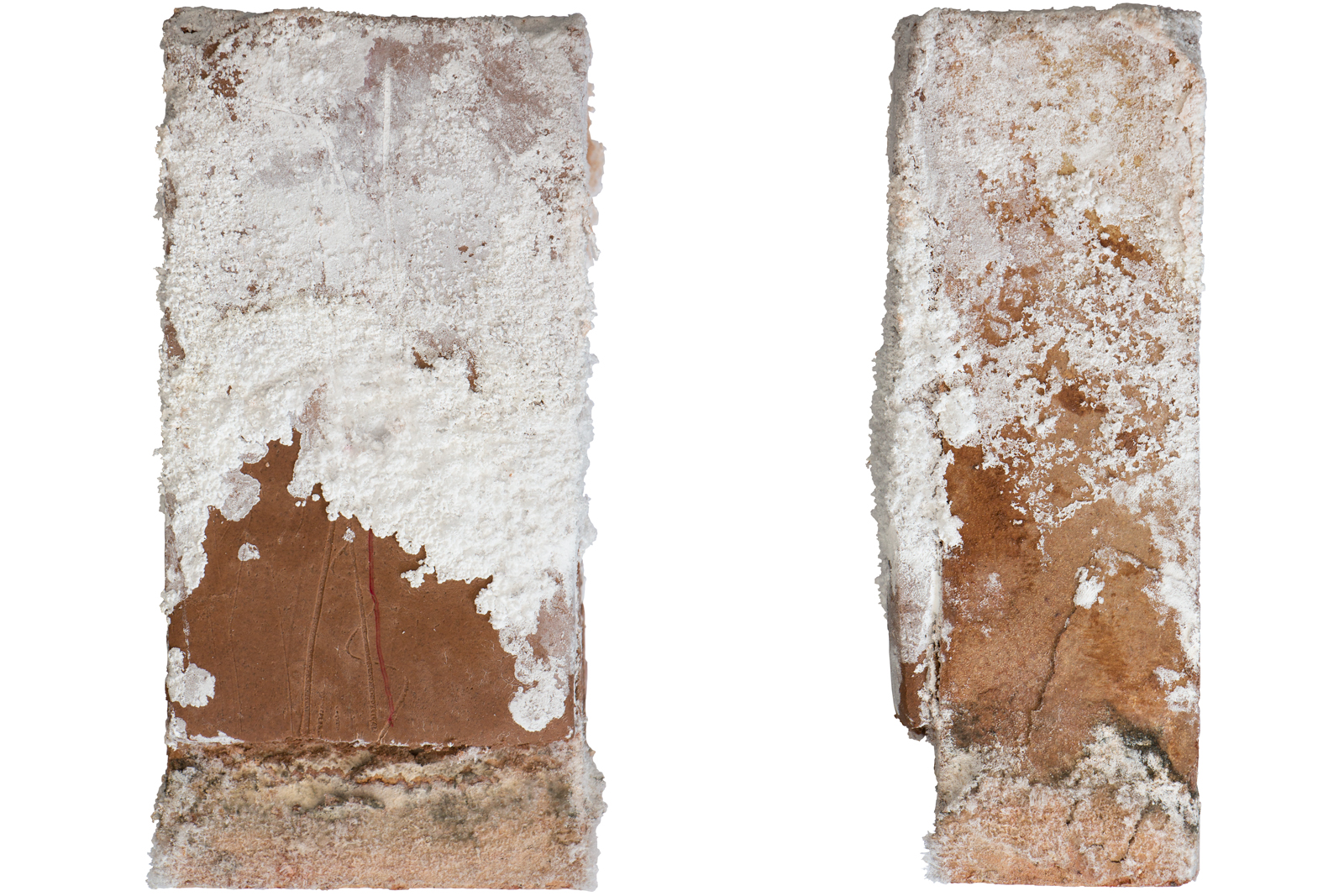Part 1: Rising Dampness
What is Rising Damp?
Rising damp in buildings may be defined as the upwards flow of moisture through a permeable wall structure, the moisture being derived from groundwater. The moisture rises through the pores (capillaries) in the masonry by a process loosely termed ‘capillarity’, which causes the masonry to act like a wick.

Electron microscope image showing pores in a brick

Figure 1: Rising damp
Rising damp (see Figure 1) varies in severity depending on several factors including the level of groundwater, the pore structure of the masonry materials (brick, stone, mortar etc…) and the rate of evaporation away from the wall surface. It often requires treatment because it has a number of undesirable effects on the performance of buildings, including:
1. Decorative Spoiling
Moisture and ground salts introduced by rising damp can cause wallpaper to peel, plaster to deteriorate, and paint to blister.


2. Erosion of the Building Fabric
Ground salts introduced into the wall by rising damp can attack and dissolve the binders in brick, stone, and mortar causing them to lose their strength and structural integrity. Crystallising salts can exert such forces that the mortar, brick, or stone microstructure is destroyed.
Salt Accumulation
…in 100 years, groundwater containing as little as 100 ppm of dissolved salts transports 4.2 kg of salt into each metre length of wall
Proceedings of the Royal Society ‐ Moisture dynamics in walls: response to micro-environment and climate change ‐ Hall, Hamilton, Hoff, Viles, and Eklund. Example based on London conditions.


3. Increased Heat Loss
Dampness in porous building materials causes a reduction of insulation properties as air in the pores is replaced by more conductive water. For example, the thermal conductivity of a wet brick has been found to be approximately twice that of a dry brick (see Figure 2).
Relationship between conductivity and brick moisture (Portsmouth University)

Figure 2: Correlation between thermal conductivity and brick moisture

Thermal image of concrete block resting in water. Lower part of image is cooler as rising damp has led to evaporative cooling
Heat loss caused by rising damp lowers the surface temperature of walls ‐ increasing condensation risk
4. Health Effects
It has been widely documented that excessive dampness in buildings can have negative effects on the health of the building’s occupants [1]
Damp and Health
In Europe, an estimated 10 ‐ 50% (depending on the country) of the indoor environments where human beings live, work and play are damp. Too much moisture makes a home stuffy and gives it a faint odour. Humid walls create a coldness that makes more heating necessary and increases energy bills.
WHO Information Brochure “Damp and Mould Health Risks, Prevention and Remedial Actions”.
[1] WHO Guidelines for Indoor Air Quality: Dampness and Mould – ISBN 978‑92‑890‑4168‑3


What Causes Rising Damp?
Rising damp occurs when moisture from the ground is “sucked” into the porous building materials from which walls are constructed through a process known as “capillarity”. This effect can be demonstrated by placing a sample of brick, mortar, or porous stone in a shallow tray of water:

The potential height to which the damp will rise in a full‐sized masonry wall will largely depend on the absorbency of the components from which it is constructed. The absorbency of the mortar is of particular importance [2]. The pore structure of some kinds of masonry materials (e.g. old lime mortars, under‐fired bricks, and certain types of sedimentary stone) results in a high degree of absorbency and masonry built using these materials is particularly susceptible to rising damp.
[2] Rising damp in masonry walls and the importance of mortar properties: Construction and Building Materials, Volume 24, Issue 10, October 2010, Pages 1815 – 1820, Dr. Eric Rirsch, Dr. Zhongyi Zhang
The rate of flow of water through the structure is dependent on pore size, shape, and connectivity. Smaller pores have greater potential for capillary rise, but larger pores have more rapid flow. So the maximum rise is determined by the distribution of pore sizes.
In practice, this potential height of rise is moderated by the fact that moisture introduced into the wall through rising damp will evaporate before it has had a chance to rise to the full potential height. For this reason, rising damp to heights exceeding 1.5 m is relatively rare except where the wall has been covered by vapour impermeable coverings such as polymer membranes, vinyl wallpapers, and certain types of wall insulation.
The height of rise also tends to be higher in other situations in which evaporation is inhibited – e.g.:
- Local Climate – rising damp will often rise higher in colder locations
- Winter vs Summer – In a European climate damp tends to rise higher during the wetter, colder winter months.
- Northerly Aspect – height of rise tends to be higher on walls with a northerly aspect (in Northern Hemisphere) as these walls are cooler than those with a southerly aspect
- Unheated house – evaporation is lower in unheated (or unoccupied) homes than in heated homes
- Thick walls – have lower evaporation rates than thin walls as their surface area is proportionally lower (see Figure 3).

Figure 3: Less surface area results in a slower rate of evaporation
Groundwork and Hygroscopic Salts
Although rising damp is caused by the process of “capillarity” described above, it is inextricably linked with another form of dampness – hygroscopic damp.
This is because rising damp transports hygroscopic (moisture attracting) salts from the ground into the building structure where they accumulate. Once present inside the fabric of the building at sufficient concentration they can cause “hygroscopic dampness” by attracting moisture from the air.

Hygroscopic damp – In this case it has not been caused by rising damp, but by hygroscopic salts in a chimney breast caused by the burning of coal
When hygroscopic damp has taken hold in a wall it becomes a cause of dampness in its own right and can therefore continue to be a problem even though the rising damp has been rectified (e.g. by installation of a new damp‐proof course). This is one of the reasons that it is sometimes necessary to carry out specialist replastering as part of a rising damp treatment. Options for replastering walls affected by rising damp are discussed later in this guide.
Salt Damage

Figure 4: Hygroscopic damp caused by soluble salts rising up the wall.
The salts responsible for hygroscopic damp (see Figure 4) can also cause damage to the masonry and plaster due to their “expansive crystallisation effects” – a term used to describe the tendency of certain salts to expand in size when they crystallise. When this occurs inside the pores of masonry materials the expansive forces can cause damage to the masonry material (e.g. plaster, brick, mortar or stone).
Treating the rising damp using an effective replacement damp‐proof course such as Dryzone or Dryrods will prevent further build‐up of salts. However plaster and masonry that has already been damaged by salts may need to be repaired or replaced.

Salt crystals through an electron microscope

A brick saturated with salt crystals
